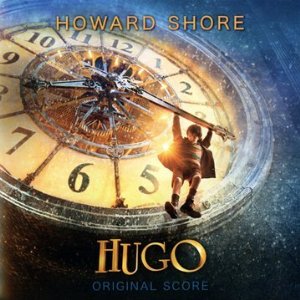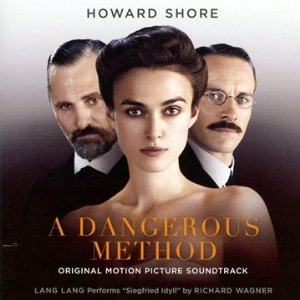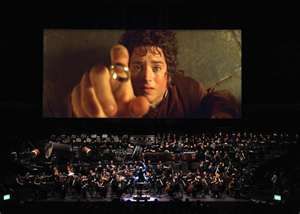In the near four decades that have taken him from being the bandleader of SATURDAY NIGHT LIVE to walking onto the stage to accept a couple of Oscars, you could say that Howard Shore has been on a continual journey of wide-eyed wonderment, one encompassing as much tender emotion as utter insanity. In over eighty scores, Shore’s used cheerful bells to embody MISS DOUBTFIRE, reached into the percussively booming pit of a serial killer’s mind in SEVEN, given a hack director the symphonic glory of Orson Welles in ED WOOD, created the mind-blowing pulsations of SCANNERS and took the side of Team Edward in ECLIPSE.
Linking these diverse scores together is a palpable musical intelligence that’s not easily sliced and diced as far as scene-dependent film scores go, a complex approach to thematic melody that often gives Shore’s works the sound of a lush concert piece. It’s an approach that’s made Shore a particular favorite of directors Martin Scorsese and David Cronenberg, both of whose latest, character-centric works have invoked especially striking work from the composer.
In HUGO, Shore turns a Paris train station into a twelve year-old’s Neverland of sparkling strings, accordions and the pure bliss of movie creation, as wrapped in a family-friendly bow that can still play a gendarme dog’s double-take.
And for A DANGEROUS METHOD that’s literally wide-eyed and open-mouthed for a woman’s madness, Shore takes the even bigger leap of reducing Wagnerian strum und drang into a beautifully transparent score, capturing all the passion of the maestro with a fraction of the symphonic fireworks. For that, you can go see a touring company give an electrifying, full-force performance of Shore’s Oscar-winning RING music that’s re-defining the scope of a true film score concert.
Now as he once more takes prolonged residence in The Shire for THE HOBBIT, Howard Shore talks about another prolific scoring year on the screen, and well beyond it.
ASSIGNMENT X: HUGO is essentially a fairy tale about the movies, and how its illusions affect real life, especially in giving a boy the power to dream amidst desperation.
HOWARD SHORE: The film is based on Brian Selznick’s wonderful graphic novel “Hugo Cabret,” which created a fictional story around the real life story of Georges Méliès. Not only was he one of the first filmmakers, but Méliès was also certainly one of the first directors to use special effects. His story is experienced through a young boy named Hugo, who lives in the train station where Méliès’ shop is.
In my own role as a composer, I always try to play my music through the point of view of the story’s main character. For a boy who’s Hugo’s age, everything is seen with wide-eyed wonder. In fact, you often see Hugo’s eyes peering out through the clocks. So it’s like a child’s view of that world, especially in how Hugo is fascinated with how machines work. And just as he studies their movements, I study the character’s actions as I work. I also collaborated closely with Martin Scorsese and his editor Thelma Schoonmaker during the editing process. We decided to reveal a lot of the score early on. In the very first reel, there are seven major themes that are developed. Then I also introduce other themes later on for Georges Méliès and his magic when we flash back in time with him.
AX: You’re a very “dense” composer, in that your music seamlessly flows with lush, full melodies that are not easily broken off from one another. When you’re scoring a film aimed at an all-family audience. Is there any trick in making your complex approach accessible for a young audience?
SHORE: Again, I just write to the character’s point of view. I don’t think you have to be a kid to understand how a twelve year-old feels. I spend a lot of time with my grandson, who’s eight. That certainly helped in my approach to HUGO. It was truly a wonderful experience to detail the relationship between Hugo and his friend Isabelle.
AX: How “French” did you want to make the score?
SHORE: Because I do all my composition in sketch form first, I don’t really deal with the “sound” of a score in the orchestrational sense. I just deal with the harmony and the counterpoint. Then I do the orchestration after that, introducing certain elements. One particular instrument that I thought would be ideal to use in HUGO was the Ondes Martenot, an electric instrument that was developed during the 1920’s, which is the same period the movie’s set in. You might call it a French Theremin.
And since the movie was dealing with mechanical inventions of the period, the Ondes fit perfectly into HUGO‘s world. I also took the sound of a café orchestra from the 20’s and used it as the core of the soundtrack, building an orchestra around it. We had quite a large number of players on HUGO, I think about 88 people. It was all detailed around the soloists.
AX: One notable aspect of your score is that when we flash back to Méliès’ origins, you actually assume the role of a silent movie accompanist.
SHORE: You’re dealing with the period of silent films, which went for quite a long time- over 30 years in fact. The thing to remember about what we call “silent films” is that they almost always had music accompaniment. You see that in the film where Georges Méliès goes to a carnival, and into a tent where the Lumière brothers are playing their landmark film ARRIVAL OF A TRAIN AT LA CIOTAT.
A live pianist is next to the screen, playing the music of Saint-Saëns, who was a popular French composer of the period. So I’m kind of working from that premise that these films aren’t truly “silent,” since you have a traditional music accompaniment to them. When we use the term “traditional” music, I think we’re really referring to the movies that we love from the 1930’s and the 40’s, films whose music derived what those original accompanists were playing during the silent era. They used popular classical music, where it was done on a solo piano, or with an orchestra.
AX: Could you tell us about HUGO’s lovely end credit song?
SHORE: It’s called “Coeur Volant,” and it was written by myself, Elizabeth Cotnoir and Isabelle Geffroy, who’s also known as Zaz. We used melodies from within the score for it, and worked with the wonderful French singer Zaz. But then, I love the idea of creating themes that you hear right at the beginning of the film, and carry right through the arch of it, from the mystery of the automaton and to the adventure of these kids and the adventure of the police inspector. So it’s particularly satisfying for me when all of those melodies finally break out into song. Zaz’s voice is just as much of a fantastic resolution to me as an instrument would be. It’s a beautiful way to end HUGO.
AX: When you’re doing a score like this, do you feel that you’re discovering as much as Hugo is?
SHORE: Oh yes. I love the adventure. Film music really lets you submerge yourself into different worlds. Here it’s the worlds of Georges Méliès and Paris in the 30’s. Why not go there? It’s a wonderful place to be.
AX: Your other major score this season is for the far more adult A DANGEROUS METHOD. It’s probably the loveliest music you’ve ever written for David Cronenberg film. Were you surprised at just how lyrical the score was compared to the visceral musical nature of many of your past collaborations?
SHORE: DEAD RINGERS certainly has a lot of beauty in it, and M. BUTTERFLY too. I think the lyrical quality is part of the film’s turn-of-the-century period, right when Méliès was making his films.
AX: In A DANGEROUS METHOD you capture the ethos of Wagner at his most delicate. For a composer who’s work is so big and bold, was it a challenge finding that subtle approach?
SHORE: “The Siegfried Idyll” was a piece that Wagner wrote for the birthday of his wife, Cosima. Its instrumentation was for a small, chamber-size orchestra, a size that seemed appropriate for this score. In the film, you see the villa that Carl Jung had on Lake Geneva. When I recalled that Wagner wrote his “Idyll” on Lake Lucerne, it became another reason that this small orchestral size was the right approach for A DANGEROUS METHOD.
AX: The last movie that of musical note dealt with the original psychoanalysts was FREUD, where Jerry Goldsmith got his first Oscar nomination for a very dark and turbulent score. A DANGEROUS METHOD definitely takes the opposite approach, though is certainly potent for it. How difficult is it to unlock those kind of raging emotions with far less obviously going on in your own take on Freud?
SHORE: One of the keys to unlocking the story of the film’s patient Sabina was her fascination with Siegfried. Freud talks about the unattainable God-like creation that she would only be able to see from afar, without being able to achieve that kind of potential. This is all part of her psychosis. So I was obviously drawing connections between the ideal of Siegfried and Wagner’s work. I wasn’t writing so much directly to the scenes as I was creating a parallel with the opera and the story that David created on film.
AX: One of the truly great film music concerts I’ve seen was the live FELLOWSHIP OF THE RING that toured this year. It was akin to watching a three-hour scoring session. Can talk a little bit about the project, and what do you think it adds to the whole canon of “live” film music?
SHORE: When you’re creating the score, you don’t have that dramatic arc of hearing how all of these pieces will fit together. It was only after assembling and releasing the complete RINGS recordings that I could really hear the piece for the first time. And I thought they were all playable in a concert setting. I wanted to hear THE FELLOWSHIP OF THE RING played in its entirety, and one of the ways to do it was to play it simultaneously with the film. I thought that maybe it was possible to do it once or twice, though I also knew it would be very difficult to do. I thought of Ludwig Wicki, who’s a Swiss conductor I’ve known for a few years. I asked him if he was interested in doing it, and thankfully he agreed. He’s the one who’s really creating these concerts so beautifully.
When I went to see FELLOWSHIP, it was like I had never seen the film in that way before. I heard the film in a new way, and saw the music. Everything was just so visual. I could feel the vibration in the concert hall of those 240 people on stage. Even the colors of the film looked different. It was a very exciting experience, kind of like an enhanced concert, or an enhanced movie going experience. You could compare it to the silent movie accompaniment we were talking about in HUGO. There’s just something pure about it. The response to FELLOWSHIP was so strong that we’ve continued it with live versions of THE TWO TOWERS and RETURN OF THE KING. Ludwig’s been playing them all over the world. Erik Ochsner, who’s assisted Ludwig, has also conducted a few RINGS concerts as well. We even had two concerts the same evening in different cities.
AX: I’d even have been thrilled if they turned off the dialogue completely and just play it with subtitles. Do you think that’s your dream for a pure RINGS concert?
SHORE: No, the Tolkien dialogue is beautiful. It all becomes part of the storytelling experience.
AX: I guess your next big epic journey is with the forthcoming two parts of THE HOBBIT. Have you been down to New Zealand where Peter’s filming them?
SHORE: Oh yes, I’m actively composing now on THE HOBBIT. I love Tolkien, and I love Peter’s work. He creates such incredible films, which makes it even better for a composer. These films are endlessly interesting to me. I never tire of them, because the RINGS films are fascinating worlds to work in. But scoring them doesn’t get any easier, I have to say! You would think after THE RETURN OF THE KING that you’ve done everything. Now there are two films ahead and it’s just a mountain to climb really, but it feels good. THE HOBBIT is quite inspiring.
AX: What do you think your scores for HUGO and A DANGEROUS METHOD say about the power of constant collaboration with directors like Martin Scorsese and David Cronenberg?
SHORE: I think good things come from that level of trust, which you build up. And the more that you work with great people like Marty, David and Peter, the more you can build on what you’ve already done and take it further. But it’s not just directors. It’s editors, cinematographers, production designers and art directors. Good movies are made when all of those elements are evenly balanced.
Thanks to Peter Hackman for his interview transcription
AGREE? DISAGREE? LET YOUR VOICE BE HEARD – COMMENT BELOW
Click on Link: Buy the HUGO soundtrack
Click on Link: Buy A DANGEROUS METHOD soundtrack
Visit the LORD OF THE RINGS concert site – here
Follow us on Twitter at ASSIGNMENT X
Fan us on Facebook at ASSIGNMENTX
Article Source: Assignment X
Article: Composer Interview with HOWARD SHORE on HUGO and A DANGEROUS METHOD
Related Posts:














